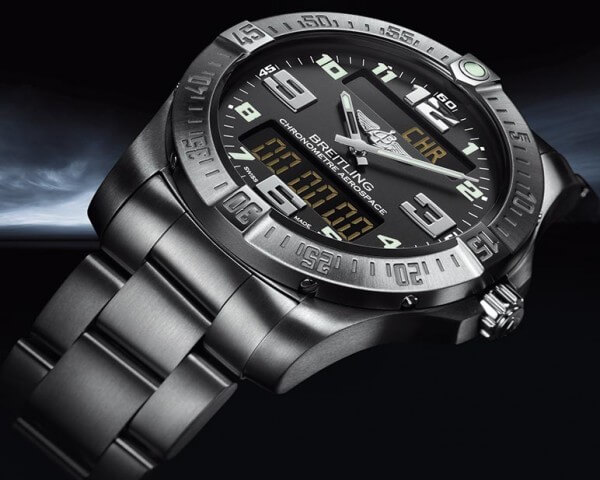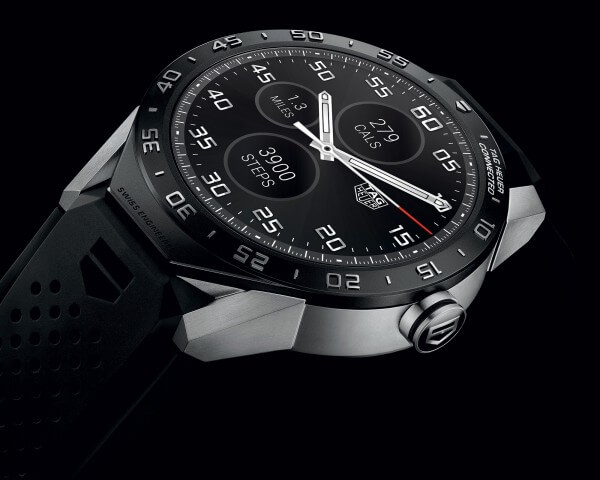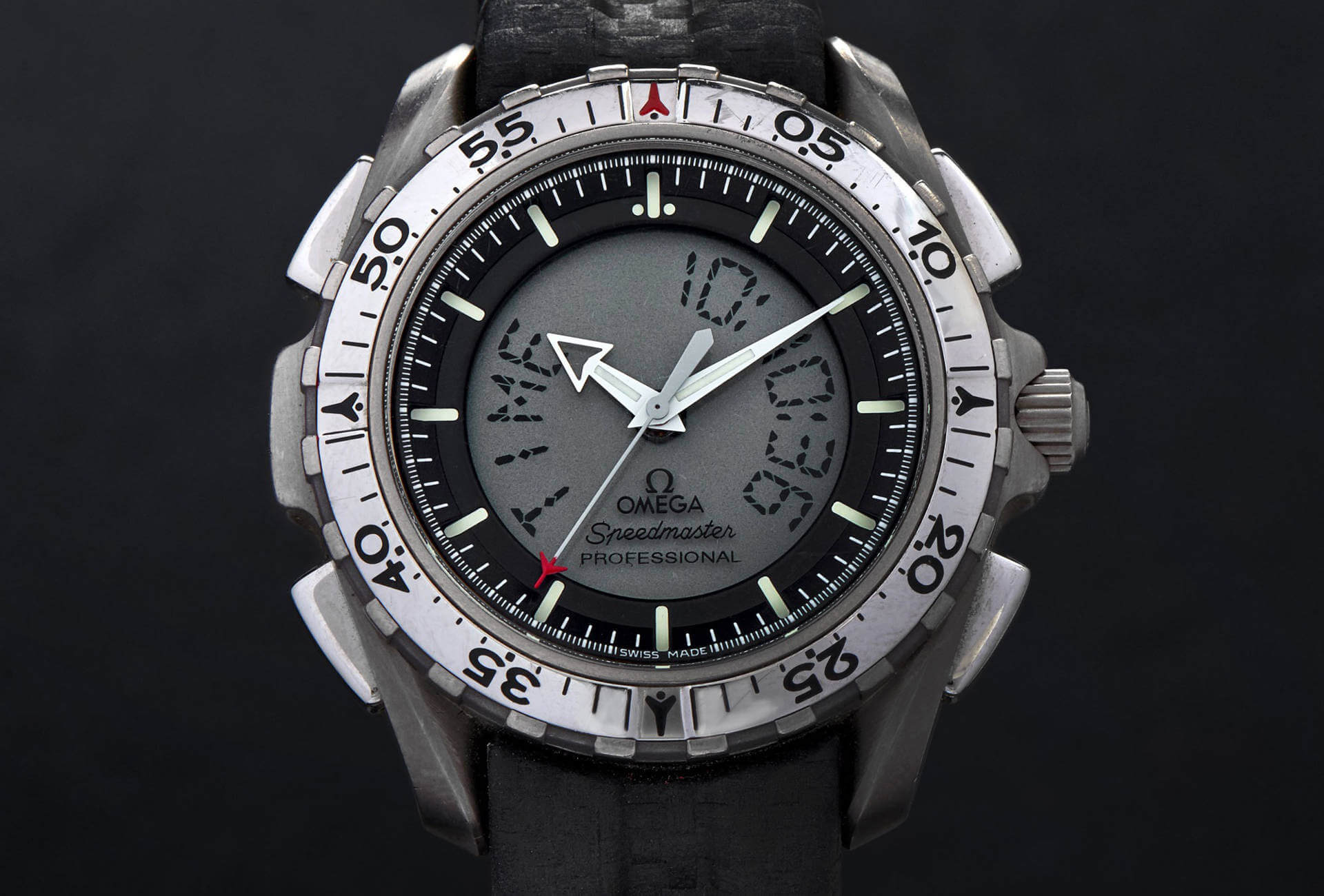After sporadic attempts, the idea of a proper Swiss tool watch matured when in 1985 Breitling released its Aerospace model; Omega responded a year later with the Seamaster Multifunction. The next step came in 1998 with the release of the Omega X-33 Speedmaster, a tool watch whose development conforms exactly with the timespan of its creation. The first generation X-33 was designed in coordination with NASA astronauts, Russian cosmonauts and professional ex-military pilots, and was initially developed as the perfect candidate to replace the ageing Speedmaster “moon watch”. The main purpose of the X-33 was to eliminate the need for multiple watches during a mission. Nothing was left to chance: every single design and manufacturing detail served a purpose and provided a solution to a problem.
The X-33 was built from lightweight, hypoallergenic titanium. The 80db alarm was a specific add-on, loud enough to be heard above the level of background noise inside the craft. It was water-resistant, shock-resistant and anti-magnetic. It displayed mission time and also had a countdown timer, UTC, a chronograph, and a light that made the display visible in the dark. Despite its impressive aviation and space pedigree, the X-33 was discontinued in the Omega catalogue in summer 2006, although it remained in service for space missions. In December 2014, Omega presented the new Omega Speedmaster X-33 Skywalker. Other examples in the same category come from Breitling (Aerospace Evo, Emergency) and Tissot with its T-Touch. The two major problems with these timepieces derive from the muddled environment surrounding their promotion.

A niche product
The first problem (top-down approach) is the rhetoric that companies use, which overwhelmingly applies the term “tool watch” anachronistically to a rugged mechanical timepiece with analogue display that used to be a genuine tool watch back in the 1950s and 60s. Every sports watch is branded a tool watch with the aim of sparking emotion and making a sale. This is an oxymoron, since most of the time an insane price, shiny surfaces and expensive materials don’t constitute a tool watch. Perhaps marketing counts more than the nature of the product these days. This tactic also creates a grey area for either the company or the consumer, as these so-called tool watches cannot keep up with the requirements of our hi-tech age. Regrettably, this state of affairs undermines any honest attempt to produce a genuine tool watch in synch with its era.
The second problem (bottom-up approach) is the customer’s perception, further amplified by the marketing approach of the companies that shoot their own tool watches in the foot. These are well-conceived products that provide every possible function the potential customer might need. However, this level of performance comes at a price, and requires a quartz calibre. Quartz technology can be hard to sell to consumers and despite its superior functionality, quartz lacks the prestige, the tradition and the nostalgia that mechanical watches have in abundance. Put simply, in customers’ minds the price of these watches doesn’t tally with their non-mechanical nature. A Swiss company can be determined to create an authentic modern tool watch, it will still come up against the fact that it will not sell satisfactorily. The first-generation X-33 is the perfect example. For this reason, every single real tool watch made by the Swiss is by definition destined to become a niche product.
In 2016, the term "tool watch" that every watchmaking company uses in abundance in its advertisements is a misnomer, used simply to appeal to the emotions.
To this confusing situation we must add the power of the Japanese. They target a different market segment, and one in which they are extremely strong. Companies such as Casio, Seiko and Citizen have carved out a dominant position by producing digital tools that are cheap and extremely well-made. This tactic began in the late 1970s, created a vacuum in the market and progressively created a stereotype in the mind of the customer who equated quartz with cheap and Japanese versus mechanical equals expensive, Swiss and luxury.

A watch fit for a queen
For all the above reasons, we might argue that the era of the proper, specialized Swiss tool watch is long gone. There are, of course, some exceptions, such as the Tissot T-Touch, Omega’s X-33 Skywalker or the Aerospace line from Breitling. These are, however, extremely niche products – for various reasons – that will enjoy limited success in a market dominated by the Japanese. Recent attempts by the Swiss to embrace smart watches, like the Connected by TAG Heuer and the Exospace by Breitling, do not constitute a move towards the tool watch and have had a mixed reception.

Conclusion: in 2016, the term “tool watch” that every watchmaking company uses in abundance in its advertisements is a misnomer, used simply to appeal to the emotions. These mechanical watches, while technologically advanced compared with their predecessors, are not tool watches per se. They are luxury items that ostentatiously give the time, a watch fit for a queen. Despite marketing claims to the contrary, these mechanical watches cannot be used as, and nor will their owners use them as tool watches. They were relevant in the 1950s and 60s and played an extremely important role in the development of the tool watch that evolved into something the vast majority of the market no longer wants.

Perhaps the most telling analogy that can be used here is a legendary name in photographic equipment: Leica. Once a genuine tool camera for countless renowned and respected photographers, it is now a posh, overpriced, highly glorified piece of equipment that is branded a tool but most of the time cannot keep up with what the Japanese have to offer. Of course, Leica cameras are built to perfection with faultless optics but they target an audience that purchases status more than the product itself.
Technology and the fast-paced global Internet culture have made the very idea of the watch superfluous.
Modern tool watches may lack the mechanical charm of their predecessors and the stories that inevitably go with them, they do possess features that epitomize the term. We have, it seems, reached a hiatus in the changing socio-technological conditions that so greatly influenced the evolution of the watch in general and the tool watch in particular. More to the point, technology and the fast-paced global Internet culture have made the very idea of the watch superfluous. The tool watch will therefore remain the preserve of the Japanese and the luxury watch that of the Swiss, with attempts by both sides to cross the divide. Sadly, these attempts will fail in the extremely tough environment of the global market, further confirming the powerful influence of stereotypes on the consumer and the industry. Excellent wristwatches from both sides will be unfairly sacrificed. After all, as Gore Vidal said (and this applies perfectly in our case): at any given moment, public opinion is a chaos of superstition, misinformation, and prejudice.














